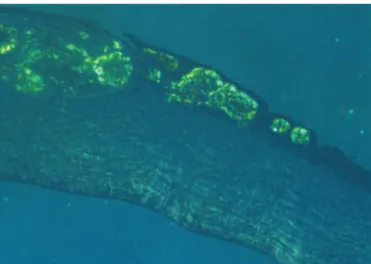3 5 6 Arq Bras Oftalmol. 2012;75(5):356-7
Relato de Caso |
Case RepoRtINTRODUCTION
Gelatinous drop-like corneal dystrophy is a rare disorder also known as primary familial amyloidosis of the cornea(1). It usually
occurs in the first decade of life and its clinical appearance can simu-late other diseases such as band keratopathy(2). Symptoms include
photophobia, tearing and poor vision. Bilateral corneal opacification increases with age. Microscopic findings include subepithelial de-posits that resemble a mulberry shape without any inflammatory component. The genetic inheritance pattern is not well established(3),
but it is believed to be autosomal recessive. Bowman’s membrane can be absent at the histopathological analysis and characteristic ap ple-green birefringence is viewed in polarized light(4).
CASE REPORT
A fiveyearold girl was referred to our Cornea and External Disea -se Department becau-se of bilateral corneal opacity and low vision. Her past medical history was negative for any systemic disease, trau-ma or prenatal disorders. Similar findings were found in her 8-year-old brother, who had the same biomicroscopic characteristic but milder symptoms. Her best corrected visual acuity was counting fingers at 1 meter in both eyes. Slit lamp examination revealed a total lack of transparency, epithelial edema with bubbles and a thin layer of
cal-cification (Figure 1). The main initial diagnostic hypothesis was con-genital hereditary endothelial dystrophy (CHED) and a penetrating keratoplasty (PK) was indicated in the right eye. Histopathological analysis revealed amyloid nodules in the subepithelial layer and in the anterior portion of the corneal stroma that stained with Congo Red (Figure 2) and formed apple-green birefringence when combined with polarized light (Figure 3). Bowman’s membrane was absent, the-re was no significant posterior stromal edema and Descemet´s mem-brane was normal. Histopathological findings were consistent with the diagnosis of gelatinous drop-like corneal dystrophy and showed that our first hypothesis of CHED was mistaken. Optical Coherence Tomography (OCT - Optovue Fourier-Domain System®
) was performed in the opposite eye that had the same clinical appearance. This exam showed increased anterior reflectivity with nodules measuring about 327 microns in thickness. Total central corneal width was 1070 mi-crons. There were no significant changes in the posterior stroma and Descemet’smembrane (Figure 4).
DISCUSSION
There are few descriptions of this type of dystrophy and no re-ports of anterior OCT images. Had we performed a corneal OCT exam before PK of the right eye, we could have made a different surgical approach since the OCT showed only anterior stromal alterations.
Optical coherence tomography image in gelatinous drop-like corneal dystrophy:
case report
Tomograia de coerência óptica na distroia corneana gelatinosa em gotas: relato de caso
OtáviOde AzevedO MAgAlhães¹, sAMuel RyMeR2, diAne Ruschel MARinhO2, séRgiO KwitKO2, isAbel hAbeyche cARdOsO3, lúciA KlieMAnn4
Submitted for publication: June 12, 2012 Accepted for publication: July 27, 2012
Study carried out at the Hospital de Clínicas de Porto Alegre, Universidade Federal do Rio Gran de do Sul.
1 Physician, Setor de Córnea e Doenças Externas, Serviço de Oftalmologia, Hospital de Clínicas de
Porto Alegre, Universidade Federal do Rio Grande do Sul - UFRS - Porto Alegre (RS), Brasil.
2 Physician, Serviço de Oftalmologia, Hospital de Clínicas de Porto Alegre, Universidade Federal do
Rio Grande do Sul - UFRS - Porto Alegre (RS), Brasil.
3 Physician, Porto Alegre (RS), Brasil.
4 Physician, Serviço de Patologia, Hospital de Clínicas de Porto Alegre, Universidade Federal do Rio
Grande do Sul - UFRS - Porto Alegre (RS), Brasil.
Funding: No specific financial support was available for this study.
Disclosure of potential conflicts of interest: O.A.Magalhães, employee of Hospital Nossa Senhora da Conceição; S.Rymer, None; D.R.Marinho, employee of Hospital de Clínicas de Porto Alegre; S.Kwitko, None; I.H.Cardoso, None; L.Kliemann,
Correspondence address: Otávio de Azevedo Magalhães. Rua Mostardeiro, 333/401 - Porto Alegre (RS) - 90430-001 - Brazil - E-mail: otaviomaga@yahoo.com.br
ABSTRACT
Gelatinous drop-like corneal dystrophy is a rare disorder with few cases described in the present literature. The following report will show how difficult it is to diagnose this disease in early stages. Modern image exams, such as optical co -he rence tomography -helps to diagnose and can be crucial to establish t-he best treatment. We will present the histopathological changes and clinical features in this unusual dystrophy.
Keywords: Corneal dystrophies, hereditary/diagnosis; Tomography, optical coheren -ce/methods; Corneal opacity; Case report; Humans; Child
RESUMO
A distrofia corneana gelatinosa em gotas é uma desordem rara e pouco descrita em nossa literatura. O caso apresentado demonstra a dificuldade de realizar o diagnóstico nas fases mais iniciais da doença. O uso de modernos exames de imagem, como a to mografia de coerência óptica de segmento anterior, auxilia no diagnóstico e pode ser crucial para definir a melhor conduta terapêutica. Apre sentaremos as alterações histopatológicas e as características clínicas desta incomum distrofia.
Magalhães OA, et al.
3 5 7
Arq Bras Oftalmol. 2012;75(5):356-7
During the diagnostic investigation, it is essential to use this kind of technology. That way, invasive procedures with high rates of rejection can be avoided. Anterior lamellar procedures or phototherapeutic keratectomy (PTK)(5) can be better options for this disease.
REFERENCES
1. Nakaizumi K. A rare case of corneal distrophy. Acta Soc Ophthal Jpn. 1914;18:949-50.
Figure 1. Gelatinous drop-like dystrophy biomicroscopic indings - grayish, mulberry-like and protruding subepithelial deposits.
Figure 2. Red Congo stain showing anterior amyloid nodular deposits.
Figure 3. Apple-green birefringence when viewed with polarized light.
Figure 4. OCT image showing hyperelective nodular formation in the anterior corneal layer.
2. Kanai A, Kaufman HE. Electron microscopic studies of primary band-shaped kerato-pathy and gelatinous drop-like corneal dystrophy in two brothers. Ann Ophthalmol. 1982;14(6):535-9.
3. Kawasaki S, Kinoshita S. Clinical and basic aspects of gelatinous drop-like corneal dys trophy. Dev Ophthalmol. 2011;48:97-115.
4. Garner A. Amyloidosis of the cornea. Br J Ophthalmol. 1969;53(2):73-81.
